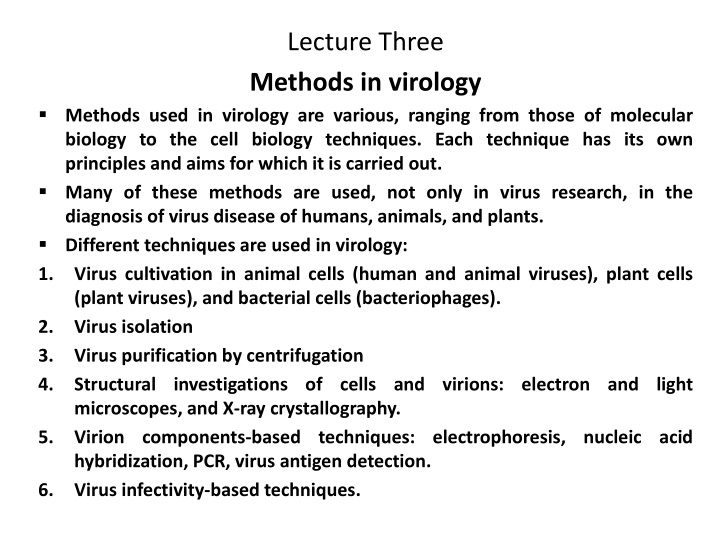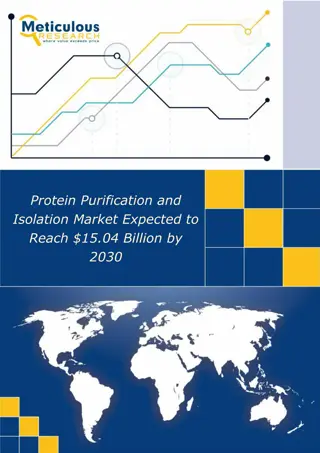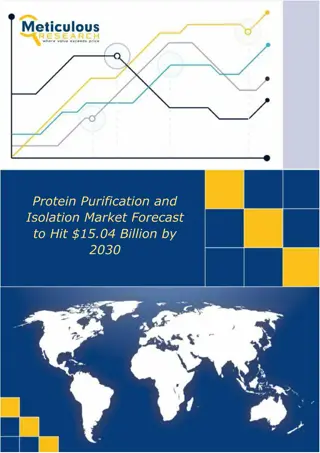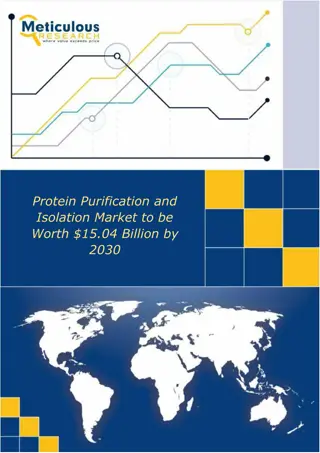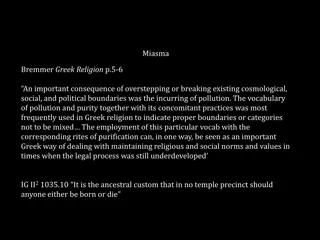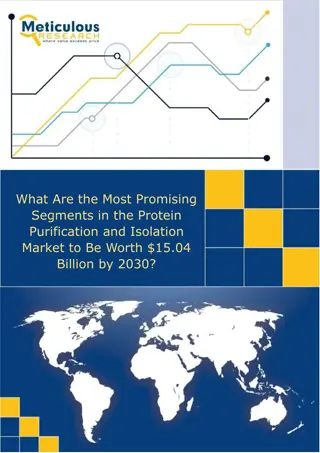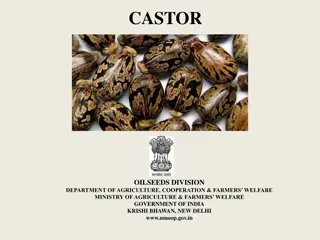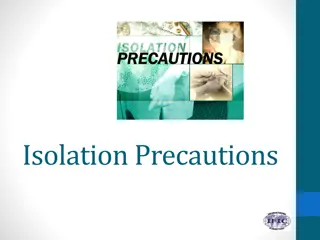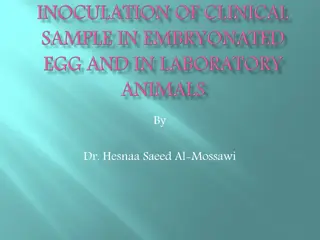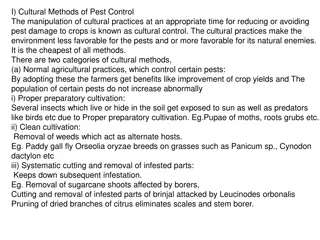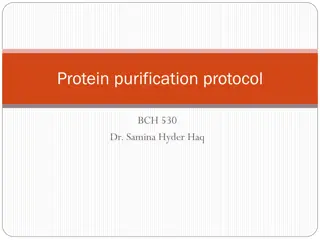Overview of Virology Methods: Cultivation, Isolation, Purification
Various methods are employed in virology, including virus cultivation in different cells, virus isolation, and virus purification through centrifugation. Structural investigations, virion component-based techniques, and virus infectivity-based techniques are also common in virology research. Understanding these methods is crucial for virus research, diagnosis, and treatment in humans, animals, and plants.
Download Presentation

Please find below an Image/Link to download the presentation.
The content on the website is provided AS IS for your information and personal use only. It may not be sold, licensed, or shared on other websites without obtaining consent from the author.If you encounter any issues during the download, it is possible that the publisher has removed the file from their server.
You are allowed to download the files provided on this website for personal or commercial use, subject to the condition that they are used lawfully. All files are the property of their respective owners.
The content on the website is provided AS IS for your information and personal use only. It may not be sold, licensed, or shared on other websites without obtaining consent from the author.
E N D
Presentation Transcript
Lecture Three Methods in virology Methods used in virology are various, ranging from those of molecular biology to the cell biology techniques. Each technique has its own principles and aims for which it is carried out. Many of these methods are used, not only in virus research, in the diagnosis of virus disease of humans, animals, and plants. Different techniques are used in virology: 1. Virus cultivation in animal cells (human and animal viruses), plant cells (plant viruses), and bacterial cells (bacteriophages). 2. Virus isolation 3. Virus purification by centrifugation 4. Structural investigations of cells and virions: electron and light microscopes, and X-ray crystallography. 5. Virion components-based techniques: electrophoresis, nucleic acid hybridization, PCR, virus antigen detection. 6. Virus infectivity-based techniques.
1. Cultivation of viruses Virus cultivation is also referred to as propagation or growth. To cultivate virus, it is necessary to supply the virus with appropriate cells in which it can replicate. Phages are supplied with bacterial cultures, plant viruses are cultivated in special plants or in protoplasts (plant cells from which the cell wall was removed), while animal viruses may be supplied with whole organisms, such as mice, egg containing chick embryos or insect larvae. However, animal viruses are grown in cultured animal cells. Tissue and cell culture consists of cells or tissues obtained from humans, animals, or plants supplied with necessary nutrients grown in aseptic conditions (free from bacteria and fungi). Below are the kinds of cell culture flasks, plates and dishes
2. Virus isolation Many viruses can be isolated as a result of their ability to form discrete visible zones (plaques) in layers of host cells. Plaques may form where areas of cells are killed or altered by the virus infection. Each plaque is formed when infection spreads radially from an infected cell to surrounding cells. Plaques can be formed by many animal viruses in monolayers if the cells are overlaid with agarose gel to maintain the progeny virus in a discrete zone. Plaques can also be formed by phages in lawns of bacterial growth. It is generally assumed that a plaque is the result of the infection of a cell by a single virion. If this is the case then all virus produced from virus in the plaque should be a clone, in other words it should be genetically identical. This clone can be referred to as an isolate, and if it is distinct from all other isolates it can be referred to as a strain. There is a possibility that a plaque might be derived from two or more virions so, to increase the probability that a genetically pure strain of virus has been obtained, material from a plaque can be inoculated onto further monolayers and virus can be derived from an individual plaque. The virus is said to have been plaque purified.
Production of plaques by animal viruses (top). Plaques formed by a phage in a bacterial lawn (bottom).
3. Virus purification After a virus has been propagated it is usually necessary to remove host cell debris and other contaminants before the virus particles can be used for laboratory studies, for incorporation into a vaccine, or for some other purpose. Virus purification can be done by centrifugation which is the most common procedure used for the purification of viruses. Partial purification can be achieved be differential centrifugation and a higher degree of purity can be achieved by density gradient centrifugation. 1. Differential centrifugation involves centrifugation, after which most of the virus is still in the supernatant, and high-speed centrifugation, after which the virus is in the pellet. 2. Density gradient centrifugation involves centrifuging particles (such as virions) or molecules (such as nucleic acids) in a solution of increasing concentration, and therefore density. Sucrose and caesium chloride are commonly used as a solute in different concentrations to form density gradient. alternating cycles of low-speed
There are two major categories of density gradient centrifugation: rate zonal and equilibrium (isopycnic) centrifugation. In rate zonal centrifugation the virus is layered over a preformed gradient before centrifugation. Each kind of particle sediments as a zone or band through the gradient, at a rate dependent on its size, shape and density. The centrifugation is stopped while the particles are still sedimenting. Equilibrium centrifugation, in which the gradient is formed during centrifugation, occurs when centrifugation continues until all the particles in the gradient have reached a position where their density is equal to that of the medium. This type of centrifugation separates different particles based on their different densities. 4. Structural investigations of cells and virions: I. Light microscopy: light microscopy has useful applications in detecting virus- infected cells, for example by observing cytopathic effects or by detecting a fluorescent dye linked to antibody molecules that have bound to a virus antigen (fluorescence microscopy).
Partial purification of virions by differential centrifugation Purification of virions by density gradient centrifugation
Confocal microscopy: is proving to be especially valuable in virology. Most confocal microscopes scan the specimen with a laser, producing exceptionally clear images of thick specimens and of fluorescing specimens. The techniques can be used with live cells and, with the virus or cell protein under investigation carrying a suitable label, e.g. green fluorescent protein (a jellyfish protein). II. Electron microscopy is involved in the investigation of the structure of virions or of virus-infected cells. Large magnifications are achieved by a transmission electron microscope but the specimen, whether it is a suspension of virions or an ultrathin section of a virus-infected cell, must be treated so that details can be visualized. Negative staining techniques, in which the stain appear as dark areas around the virion, allow to determine virion shape and size. III. X-ray crystallography is another technique that is revealing detailed information about the three-dimensional structures of virions (and DNA, proteins and DNA protein complexes).
5. Virion components-based investigations I. Electrophoretic techniques can be used for separation of virion components (nucleic acid and protein) by electrophoresis in a gel composed of agarose or polyacrylamide. In this technique, the rate of movement of nucleic acids or proteins depends on molecular weight of the molecules. The molecular weights of the protein or nucleic acid molecules can be estimated by comparing the positions of the bands with positions of bands formed by molecules of known molecular weight electrophoresed in the same gel. The patterns of nucleic acids and proteins after electrophoretic separation may be immobilized by transfer (blotting) onto a membrane. If the molecules are DNA the technique is known as Southern blotting, named after Edwin Southern; if the molecules are RNA the technique is known as northern blotting, and if the molecules are protein the technique is known as western blotting.
Separation of proteins and estimation of their molecular weights using gel electrophoresis
II. Detection of virus antigens Virus antigens can be detected using virus-specific antisera or monoclonal antibodies. In most techniques positive results are indicated by detecting the presence of a label, which may be attached either to the antivirus antibody (direct tests) or to a second antibody (indirect tests) The anti-virus antibody is produced by injecting virus antigen into one animal species and the second antibody is produced by injecting immunoglobulin from the first animal species into a second animal species. Principles of test to detect virus antigens, Direct and indirect tests
III.Detection of virus nucleic acids A. Hybridization: Virus genomes or virus messenger RNAs (mRNAs) may be detected using sequence-specific DNA probes carrying appropriate labels. Hybridization may take place on the surface of a membrane after Southern blotting (DNA) or northern blotting (RNA). Thin sections of tissue may be probed for the presence of specific nucleic acids, in which case the technique is known as in situ hybridization. Detection of a specific nucleic acid (DNA or RNA) using a labelled DNA probe.
B.Polymerase chain reaction (PCR) When a sample is likely to contain a low number of copies of a virus nucleic acid the probability of detection can be increased by amplifying virus DNA using a PCR, while RNA can be copied to DNA and amplified using a RT (reverse transcriptase)- PCR. The procedures require oligonucleotide primers specific to viral sequences. An amplified product can be detected by electrophoresis in an agarose gel, followed by transfer to a nitrocellulose membrane, which is incubated with a labelled probe. IV. Detection of infectivity using cell culture Not all virions have the ability to replicate in host cells. Those virions that do have this ability are said to be infective , and the term infectivity is used to denote the capacity of a virus to replicate. Virions may be non-infective because they lack part of the genome or because they have been damaged. To determine whether a sample or a specimen contains infective virus it can be inoculated into a culture of cells, or a host organism, known to support the replication of the virus suspected of being present. After incubation of an inoculated cell culture at an appropriate temperature it can be examined by light microscopy for characteristic changes in the appearance of the cells resulting from virus-induced damage. A change of this type is known as a cytopathic effect (CPE); examples of CPEs induced by poliovirus and herpes simplex virus. See the figure below.
Cytopathic effects caused by replication of poliovirus (left) and herpes simplex virus (right) in cultures of monkey kidney.
6. Virus infectivity-based techniques An infectivity assay measures the titre (the concentration) of infective virus in a specimen or a preparation. Samples are inoculated into suitable hosts, in which a response can be observed if infective virus is present. Suitable hosts might be animals, plants or cultures of bacterial, plant or animal cells. Infectivity assays fall into two classes: quantitative and quantal. Quantitative assays are those in which each host response can be any one of a series of values, such as a number of plaques. A plaque assay can be carried out with any virus that can form plaques, giving an estimate of the concentration of infective virus in plaque-forming units (pfu). The number of plaques is inversely proportional to the virus dilution. In a quantal assay each inoculated subject either responds or it does not; for example, an inoculated cell culture either develops a CPE or it does not; an inoculated animal either dies or it remains healthy. The aim of the assay is to find the virus dose that produces a response in 50 per cent of inoculated subjects. In cell culture assays this dose is known as the TCID50 (the dose that infects 50 per cent of inoculated tissue cultures). In animal assays the dose is known as the ID50, and where the virus infection kills the animal the dose is known as the LD50 (the dose that is lethal for 50 per cent of inoculated animals).
